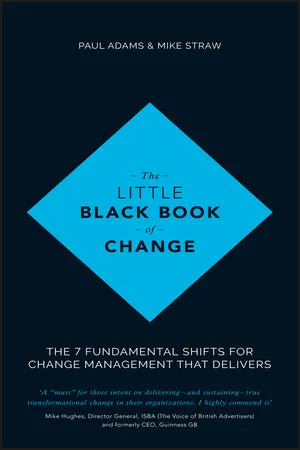
The Little Black Book of Change
The 7 Fundamental Shifts for Change Management that Delivers
- English
- ePUB (mobile friendly)
- Available on iOS & Android
The Little Black Book of Change
The 7 Fundamental Shifts for Change Management that Delivers
About this book
Your go-to-guide to delivering effective and transformative change that lasts
All too often, change efforts fail to deliver on their promise. However it is possible to turn an organization around quickly to create a new future — one where people think and behave differently and deliver extraordinary results together. Whether you are the chairman, a board director or an aspiring senior executive, The Little Black Book of Change provides a practical, concise and insightful guide to understanding your organization and inventing something extraordinary. It is not about 'run of the mill' change programmes. It is about delivering extraordinary results — something that is not at all predictable. It will be your insight into creating significant shifts in the way people think and behave which can be applied in any area you wish; from improving service levels to cost reductions, innovation or increasing market share.
- Demystifies organisational transformation in 7 practical steps
- Based on real business case studies
- Grounded and accessible, rather than purely from theoretical models or processes
- The authors have 25 years' experience of implementing and facilitating transformations change
- Visit http://www.littleblackbookofchange.com/
Frequently asked questions
- Essential is ideal for learners and professionals who enjoy exploring a wide range of subjects. Access the Essential Library with 800,000+ trusted titles and best-sellers across business, personal growth, and the humanities. Includes unlimited reading time and Standard Read Aloud voice.
- Complete: Perfect for advanced learners and researchers needing full, unrestricted access. Unlock 1.4M+ books across hundreds of subjects, including academic and specialized titles. The Complete Plan also includes advanced features like Premium Read Aloud and Research Assistant.
Please note we cannot support devices running on iOS 13 and Android 7 or earlier. Learn more about using the app.
Information
Shift 1
LETTING GO OF THE PAST

Lead from the future
“Using your past as a point of reference binds you to only those possibilities that lie inside the boundaries of that which you know.”
“While theoretically and technically television may be feasible, commercially and financially, I consider it an impossibility.”Lee de Forest (inventor of vacuum tube/electronic valve), 1926.
Avoid normalizing
- Looking for solutions within the existing environment.
- Rationalizing and justifying.
- Going for something bold, only to revert to wherever the previous bar was set.
- Being driven by poor assumptions.
- Carefully managing risk.
- Making excuses and reverting to their old ways.
- Finding it hard to resolve problems/setbacks.
“IT’S ALWAYS LIKE THIS; IT HAPPENS EVERY YEAR”
How to let go of the past
| Traditional Leaders: | Transformational Leaders: |
|
|
Creating a vision “free” of the past
The challenge
Table of contents
- Cover
- Epigraph
- Title page
- Copyright
- A NOTE FROM THE AUTHORS
- INTRODUCTION
- Shift 1 LETTING GO OF THE PAST
- Shift 2 DEVELOPING BREAKTHROUGH AMBITION
- Shift 3 CREATING A BOLD NEW VISION OF THE FUTURE
- Shift 4 ENGAGING THE PLAYERS IN THE BOLD NEW FUTURE
- Shift 5 CUT TING THROUGH THE DNA
- Shift 6 KEEPING THE ORGANIZATION FUTURE-FOCUSED
- Shift 7 GAINING ENERGY FROM SETBACKS
- SUMMARY
- FINAL THOUGHTS
- ABOUT THE AUTHORS
- ACKNOWLEDGEMENTS
- THE EXTRAORDINARY PEOPLE CLUB …
- EULA